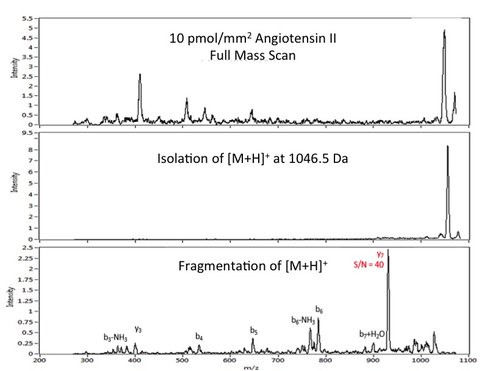2015 Annual Science Report
 NASA Goddard Space Flight Center
Reporting | JAN 2015 – DEC 2015
NASA Goddard Space Flight Center
Reporting | JAN 2015 – DEC 2015
Analytical Protocols and Techniques for Detection and Quantitative Analysis of Complex Organics in Planetary Environments
Project Summary
Robotic planetary missions enable critical in situ investigations into the character, diversity and distribution of organic compounds in their native environments. The next-generation mass spectrometers being developed for planetary exploration promise enhanced capabilities to elucidate the molecular structure of detected organic compounds via tandem mass spectrometry (MS/MS), and to disambiguate potential biosignatures via ultra high-resolution mass discrimination. The in situ detection and potential sequencing of individual organic polymers using synthetic trans-membrane nanopores is another example of an innovative technology geared towards the identification of key organic compounds. We are engaged in evaluating and extending such innovative technologies to address astrobiological initiatives on future NASA missions.
Project Progress
In 2015, we continued to explore the selective ion enrichment and tandem mass spectrometry (MS/MS) capabilities of the Mars Organic Molecule Analyzer (MOMA, for flight on ExoMars 2020) in greater depth, with support from NAI through the GCA. These analytical methods and performance demonstrations may be extended to future missions, leveraging the linear ion trap core of the MOMA design; such future instrument concepts include the MatISSE- and PSTAR-funded Linear Ion Trap Mass Spectrometer (LITMS) and the PICASSO-funded AROMA instrument described above. A particularly promising direction is the potential ability to identify oligomeric compounds in pulsed laser desorption/ionization (LDI) spectra with a MOMA-like ion trap. In the example shown (Figure 1), the peptide Angiotensin II produces a high-m/z peak (1046 Da) of the molecular ion. In this mass range such a signal would be expected to stand out from the complex peak distribution over lower-m/z values arising from the mixture of mineral and smaller organic species in a natural sample. By isolating and fragmenting this peak while it remains in the ion trap, we obtain a pattern of lower-m/z peaks with neutral losses characteristic of the individual amino acids that serve as links in the molecular chain. We have been developing a library of fragment patterns for chain and non-chain compounds using various “bath gas” mixtures corresponding to different planetary atmospheric conditions.
In parallel we continue to examine the use of laser time-of-flight mass spectrometer (TOF-MS) techniques to develop protocols for organics analysis on a range of potential mission scenarios, including comet, asteroid, and Titan landers. With 2015 NAI support we have demonstrated that a second pulsed laser can be used to induce fragmentation of ions in a molecular beam, much in the same way that RF excitation and collisions cause fragmentation in an ion trap, enabling MS/MS in even a highly-miniaturized TOF-MS. Figure 2 shows an example resulting from “laser-assisted collision-induced fragmentation (LA-CID)” spectrum from captured benzene-based and pyridine-based aerosols as simulants of Titan haze components. This protocol is enabled by the configuration of our two-step laser mass spectrometer (L2MS) instrument under development with PIDDP funding. The second laser is “re-purposed” operationally to induce fragmentation of prompt ions, rather than serving as the post-ionization source. This result leads to the possibility of one day deploying on a planetary mission a highly-capable instrument with both L2MS and LA-CID capabilities. A manuscript describing these enhancements is being prepared.
The GCA NAI effort additionally supported the development of a medium resolution (M/ΔM = 2500 at 5% peak height) in situ analytical method to measure rare earth elemental abundances in ancient Earth materials (e.g., Archean zircons) as well as individual meteorite phases via laser ablation mass spectrometry. A manuscript describing this method is being drafted currently and will be submitted to Geostandards and Geoanalytical Research before the end of Q1 in CY2016. NAI funding also supported the demonstration of a second analytical method relying upon medium resolution mass discrimination, leading to quantitative abundance measurements for first row transition elements preserved in olivine and pyroxene grains derived from ancient Archean komatiites. Abundances of these elements serve as local indicators of oxygen fugacity levels (fO2) and provide insights into the geological processes that govern planetary differentiation. A manuscript including these critical analyses is also being drafted.
The detection of individual oligomeric molecules through nanopore technology is also being prioritized and ramped up for performance definition. An undergraduate student intern has been awarded an Astrobiology Program grant to work on this technology in support of NAI objectives in CY2016.
-
PROJECT INVESTIGATORS:
-
PROJECT MEMBERS:
Stephanie Getty
Collaborator
-
RELATED OBJECTIVES:
Objective 2.1
Mars exploration.
Objective 2.2
Outer Solar System exploration
Objective 7.1
Biosignatures to be sought in Solar System materials



